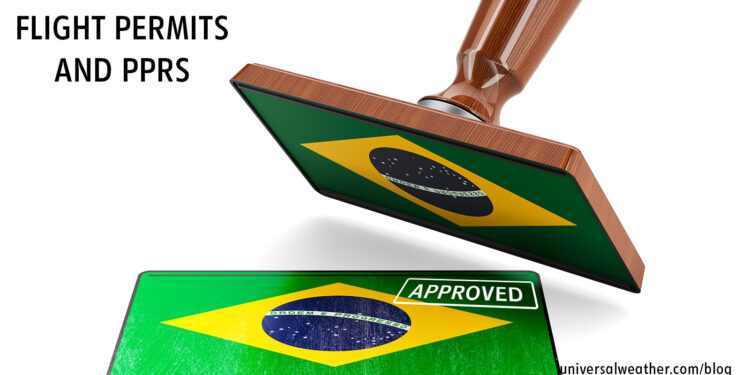8 FAQs on Flight Permits and PPRs in Brazil

This is a post by author Andre Camargo. Andre is Country Manager for Universal Aviation Brazil which has aircraft ground handling facilities in São Paulo, Brasilia, Manaus, Recife, and Rio de Janeiro. Andre is an expert on business aircraft operations in Brazil and can be contacted at andrecamargo@universalaviation.aero.
This business aviation blog post is part of a series on operating to Brazil.
Generally speaking, flight permit and Prior Permission Required (PPR) requirements for business aircraft operators flying in Brazil are not onerous and remain relatively flexible. Permits allow for deviations. However, there are local regulations that make the permit process in Brazil unique, in the manner in which a request is processed. We recommend you always confirm documentation requirements in advance and be aware of non-standard procedural requirements.
To assist you with planning your flight to Brazil, here are the answers to some common questions regarding our local flight permit process:
1. What’s required to obtain a domestic landing permit for Brazil?
You’ll need to provide standard aircraft, passenger, and crew details, including certificate of airworthiness, registration, insurance with 3rd-party liability coverage, crew type rated licenses and first class medical certificates. Brazil’s Civil Aviation Authority (CAA) requires at least 48 hours’ notice to process landing permit requests. Permits are valid for planned day of arrival with a deviation of 24 hours prior and 48 hours after your Estimated Time of Arrival (ETA). Your permit will be validated after arrival when customs is cleared. Customs decides on the timeframe of your permit, which can be a maximum of 60 days. If you want to stay beyond the approved date, 15 days is required to revise the permit, but it may be approved within a shorter timeframe at CAA’s discretion. Permit revisions are required for crew changes or if your arrival is beyond the approved deviation. No revision is necessary for changes in passengers, destination, departure point, or schedule if it’s still within the permitted deviation.
2. Is a landing permit required for a tech stop in Brazil?
For a single tech stop with no other stops in Brazil, a landing permit notification only is required. For the notification, you’ll need to provide CAA with your tail number, country of registration, aircraft type, max landing and takeoff weights, name of Pilot in Command (PIC), address of operator, name of operator, e-mail address of operator, type of flight (charter [non-scheduled commercial] or private non-revenue), departure point to Brazil, destination in Brazil, and next destination point. Deviation for a tech stop permit is -24 hours/+24 hours of estimated ETA.
3. What are current rules on overflight permits?
An overflight permit is now required (where it was not needed in the past) if you enter Brazilian airspace, over the landmass or water. This involves notification only, and you will not be given a permit number. Notification requirements are the same as if you’re making a single tech stop in Brazil. Deviation is -24 hours/+24 hours of estimated ETA.
4. Are there differences in permits and requirements for private non-revenue and charter (non-scheduled commercial) operators?
No. Brazil CAA considers all charter as private flights. Only scheduled commercial flights are considered ‘charter’ or ‘commercial.’ As this information is subject to change, it’s always best to confirm with your 3rd-party provider pre-departure.
5. Do any local regulations impact overflight or landing permits for Brazil?
Brazil CAA processes permit requests, while customs validates permits. Landing permits are only validated after customs clearance. For non-Brazilian registered aircraft, there are cases where permit validity isn’t approved for a long period of time. Your ground handler will be able to provide guidance regarding the validity period extension options.
6. Is cabotage a factor impacting charter flights to Brazil?
Cabotage is not applicable for private or charter aircraft operating to Brazil. Cabotage only affects scheduled commercial flights.
7. What is required lead time for PPRs?
In Brazil, PPRs are utilized only for aircraft parking purposes. They’re required at Vitoria, Brazil (SBVT), and Guarulhos, Sao Paulo, Brazil (SBGR), and may be needed at Campinas, Brazil (SBKP) in the future. This is determined by local authorities at a later time. To obtain a PPR, send tail number, firm schedule, and operator information to airport authorities, or to your ground handler, who can request this for your trip. Requests should be made as early as possible due to frequent lack of aircraft parking spaces at these airports.
8. How are landing permit charges determined and payments made?
Landing permit charges are standard, regardless of aircraft type, and included in the landing fee. Landing fees must be paid after arrival to the airport authorities, prior to departure to your next destination. Upon payment, you’ll be given a number, which must be put in “remarks 18” when filing your flight plan.
Conclusion
Landing permits for Brazil can be arranged with relatively little lead time. However, the permit process is a little more complex for operators intending to fly domestic legs within Brazil. It’s best to work with your 3rd-party provider to secure landing permits with the longest permit validity and maximum flexibility.
Questions?
If you have any questions about this article, contact me at andrecamargo@universalaviation.aero.
Next week, we’ll discuss flight planning for Brazil.




